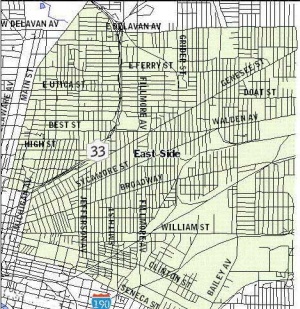On this page:
What are race-based health disparities and inequities?
Health disparities and health inequities are differences between the health outcomes of Whites and people of color in terms of length of life, quality of life, and social well-being. In the United States, life expectancy is 79 years, and any death occurring before that age is premature. The quality of life refers to the average number of good physical days a person has yearly, and is related to social well-being, which refers to a state of complete physical and mental well-being. Studies of health disparities and health inequities explore the dynamics of the most destructive element of racial oppression in the United States — health inequity.
Why is a discussion of these issues so crucial to Black Buffalo? If disease ravages African Americans, it will cause them to spend many days feeling sick and tired. Therefore, we commit ourselves to the battle to improve health outcomes for African Americans.
Health disparities and health inequities fuse with racial and social justice, as well as human rights. The Institute defines race-based health disparities as differences in health outcomes between Blacks, and people of color, and Whites. These health differences are rooted in socioeconomic inequities between whites and people of color based on systemic structural racism. The disparities measure stresses the disproportionate race-based health outcomes between Whites and people of color, while the health equity definition stresses the injustice and oppression that undergirds these differences. The undesirable health outcomes result from the deliberate creation of neighborhood and societal conditions that lead to the social determinants that result in these adverse health outcomes. Thus, health disparities are useful for assessing the health status of Blacks and people of color, but health equity is the most appropriate term for defining the health outcome goals for those communities.
Why should health disparities matter to someone living on the East Side of Buffalo?
The complete picture of health is made up of all of the determinants of health. We generally focus on factors like heredity, what we eat, and how much we exercise. But the social determinants of health are a greater portion of the picture of health. These factors make up most of our health. We should care about them because they determine the quality of our education, the livability and safety of our homes and neighborhoods, and access to resources like healthy food and healthcare. In America, many of these factors are determined by race. In cities like Buffalo, these determinants manifest in disparities in health outcomes. The social determinants of health increase or decrease the number of years we live and the quality of life that we have.
Why should health disparities matter if you don’t live on the East Side, but live elsewhere in Western New York?
Reducing the rate of health disparities on the East Side and throughout Buffalo proper is a public good that will benefit Buffalonians at every income level. The negative repercussions of health disparities go beyond just the individual and extend to their children, whole communities, and society at large. Disparities in health and healthcare not only affect the groups facing disparities, but also limit overall gains in quality of care and health for the broader population.
Knowing why and how some populations suffer disproportionate health disparities and what role the environment, safe housing, race, ethnicity, education, socioeconomic status, and access play in that suffering can prepare us to begin to alleviate such hardships. Here are reasons why improving the quality of health for our neighbors east of Main Street should matter to those who do not reside there, and why we all have a vested interest:
- Improving the health of individuals in the most disadvantaged communities improves the overall health of our city. Addressing disparities in health and healthcare is important from an equity standpoint and also for improves overall quality of care and population health. If you care about the City of Buffalo and its surrounding areas, you care about the health disparities that define it.
- Improving the health of individuals in our most disadvantaged communities will increase the likelihood that your children will engage with healthy people around the city. With that in mind, addressing health disparities becomes increasingly important as the population becomes more diverse. It is projected that people of color will account for over half (52%) of the population in 2050. Healthier communities lead to safer communities.
- Knowledge of health disparities in the most disadvantaged communities helps you and your loved ones avoid the impact of that disparity. Knowledge is power.
- Improving the health of individuals in the most disadvantaged communities leads to lower taxes and healthcare costs. Disparities in health lead to unnecessary health care costs that increase financial burdens on taxpayers through the form of Medicaid and emergency room use. Health disparities lead to approximately $93 billion in excess medical care costs and $42 billion in lost productivity per year as well as economic losses due to premature deaths. For example, as of 2018, Latinx individuals are two-and-a-half times more likely to be uninsured than whites (19% vs. 7.5%). People with incomes below poverty are four times as likely to lack coverage as those with incomes at four times the federal poverty level or above (17.3% vs. 4.3%).
- Improving the health of individuals in the most disadvantaged communities
- Reduces fear and stigmatization of communities.
- Translates into more business for the region.
- Is the right thing to do!

